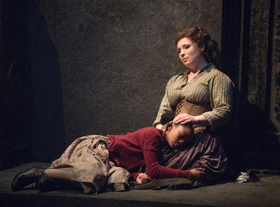Review: JACK THE RIPPER: THE WOMEN OF WHITECHAPEL, London Coliseum

![]() In February this year, historian Hallie Rubenfold brought out a poignant book describing the backstories of the five women killed in 1888 by a murderer nicknamed Jack the Ripper. It has always seemed a poor reflection on society that the victims of such horrific crimes have been almost forgotten in the midst of the ever-increasing celebrity and mystery of Jack himself.
In February this year, historian Hallie Rubenfold brought out a poignant book describing the backstories of the five women killed in 1888 by a murderer nicknamed Jack the Ripper. It has always seemed a poor reflection on society that the victims of such horrific crimes have been almost forgotten in the midst of the ever-increasing celebrity and mystery of Jack himself.
Iain Bell's new opera, Jack the Ripper: The Women of Whitechapel, claims to do something similar: to refocus the story on the women themselves and how they cope in the face of a brutal murderer stalking them. With such remarkable material at their fingertips, it is a shame that Bell and librettist Emma Jenkins fail to take advantage of the dramatic potential of the story, with an overly long and sometimes turgid production.
At a time when life was incredibly brutal and hard, with no welfare state, Bell and Jenkins show great respect for the women who were murdered, avoiding cliché or pastiche. The consequence of this is a distinct lack of drama or tension in the production. This is emphasised by its length, which at three hours could easily be trimmed considerably.
Under Daniel Kramer's direction, a stellar cast of ENO veterans include an energetic Lesley Garrett as the cheeky and consistently drunk Catherine Eddowes, Susan Bullock as her partner-in-crime Liz Stride, Janis Kelly as the put-upon Polly Nichols, and Marie McLaughlin as the motherly Annie Chapman.
However, they are all given little depth of material to work with, and it seems a shame to underuse such a lot of talent. Only a superb Natalya Romaniw as Mary Kelly is given any kind of substance to her story, as she fights to protect her young daughter from the vices that surround her.
Romaniw is the standout in the production, with a strength and clarity to her soprano that is sharpened by her excellent acting. After her wonderful appearance in last year's La bohème, it is great to see her continuing to excel.
It's also refreshing to see so many older women given parts. Dame Josephine Barstow plays Maud, the dosshouse owner. With over 50 years of experience under her belt, she creates a cruel and embittered woman, adding a steeliness and harshness to her voice that is chilling.
Iain Bell's music uses haunting and shimmering strings to convey the sinister darkness of the streets of London, but overall the score lacks variety and often seems repetitive, despite the ever-reliable Martyn Brabbins conducting the excellent ENO orchestra.
There are some very effective moments, such as the opening to Act II, where a captivating Bullock staggers around the stage singing emphatically about her love for firemen; this morphs into a kind of grotesque, drunken nursery rhyme about the women of the streets being picked off one by one. There is also a powerful, if overlong, finale, aided endlessly by a pulsating performance by Romaniw, as Mary succumbs to her fate.
Soutra Gilmour's shadowy, grimy and sinister design works well with Paul Anderson's stark lighting. Small apertures where the gentlemen clients stick their heads and hands through the walls of the dosshouse emphasise the objectification and lack of choice for the women inside.
The essence of this production is suitably bleak and joyless for the subject matter, but there is not enough drama or climax to complement all that darkness. The supposed purpose of this opera is to give the victims a voice, but the result is more like a whisper.
Jack The Ripper: The Women of Whitechapel is at the London Coliseum until 12 April
Photo Credit: Alistair Muir
Reader Reviews

Videos
